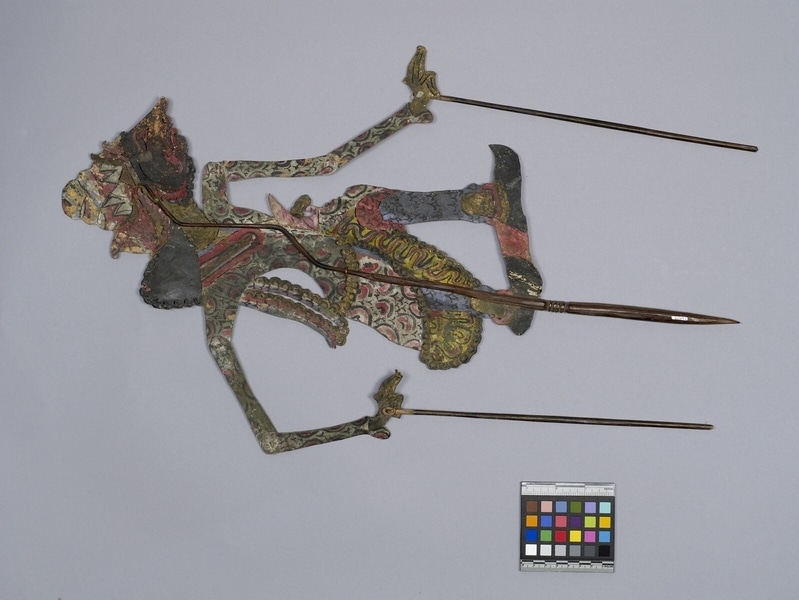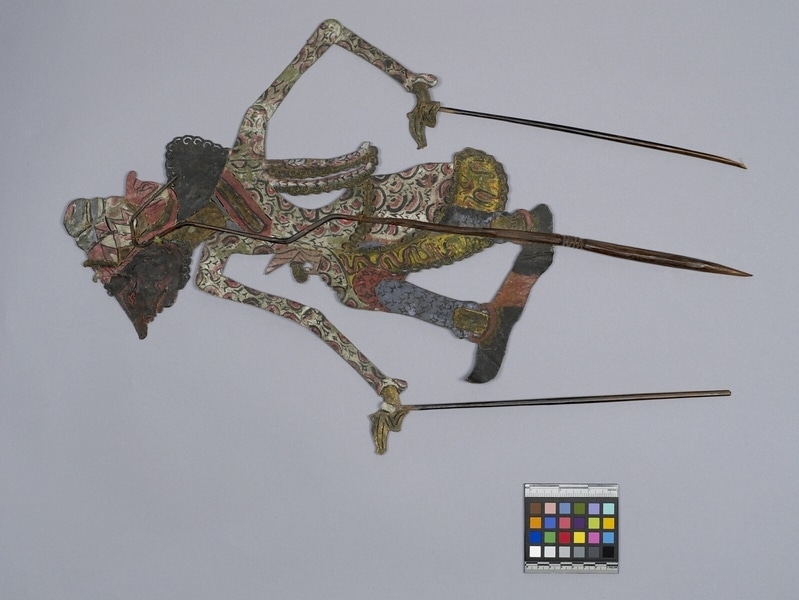Shadow Puppet Item Number: Ib419 from the MOA: University of British Columbia


Description
Two-dimensional male humanoid figure; large head and jointed arms attached to controlling rods. Body and face in profile; pierced, elaborate designs and features. Red face positioned forward with long straight nose. Red details on face (moustache, eyebrows). Small eyes, beard. Very rough headdress with (?) diadem, wrapped hair, and sumping. Red Garuda. Long black hair (?). Gold neck and body: hands are held with three fingers extended, two touching to thumb. Upper body covered with painted grey pattern (faded and stained), black and red, with band over shoulder (red and black). Yellow, red and black skirt (blue stocking ?). Plain upturned shoes; legs widespread.
History Of Use
Wayang kulit is the predominant theatrical form of eastern and central Java. The art form has its roots in the regional mythology, which was incompletely replaced by the Hinduism of invading Indians. The form has survived since then intact, even through the Islamic conquest, showing no Muslim influence whatsoever. Plays, derived from the Mahabharata and Ramayana cycles of legends, are performed by a dalang (puppet master) on special occasions, in three acts with vocal and instrumental accompaniment. Typically they serve a moral purpose, such as the fight between good and evil. Indra is a god (betara) found in all cycles. He is heir apparent to his father, Siwa, and father to Arjuna.
Iconographic Meaning
Each puppet is characterized by it's wanda, a Javanese word which describes the specific mixture of elements of size, form, colour, ornamentation, and carving. Features and position of face suggest some virtue and refinement; colour does not. Position of hands, colour of skin, and wound headdress indicate nobility. Stance suggests some aggressiveness. Character possibly a representation of Indra (because of headdress).
Cultural Context
Theatrical performance.
Item History
- Made in Java, Indonesia
- Owned by Lucinda Jones before January 11, 1979
- Received from Lucinda Jones (Seller) and Museum of Anthropology Donations Fund (Funding source) on January 11, 1979
What
- Name
- Shadow Puppet
- Identification Number
- Ib419
- Type of Item
- puppet
- Material
- leather skin, hemp fibre, fibre and paint
- Manufacturing Technique
- cut, pierced, tied and painted
- Overall
- height 62.2 cm, width 22.0 cm
Who
- Culture
- Javanese
- Previous Owner
- Lucinda Jones
- Received from
- Lucinda Jones (Seller) and Museum of Anthropology Donations Fund (Funding source)
Where
- Holding Institution
- MOA: University of British Columbia
- Made in
- Java, Indonesia
When
- Ownership Date
- before January 11, 1979
- Acquisition Date
- on January 11, 1979
Other
- Condition
- poor
- Accession Number
- 0503/0001